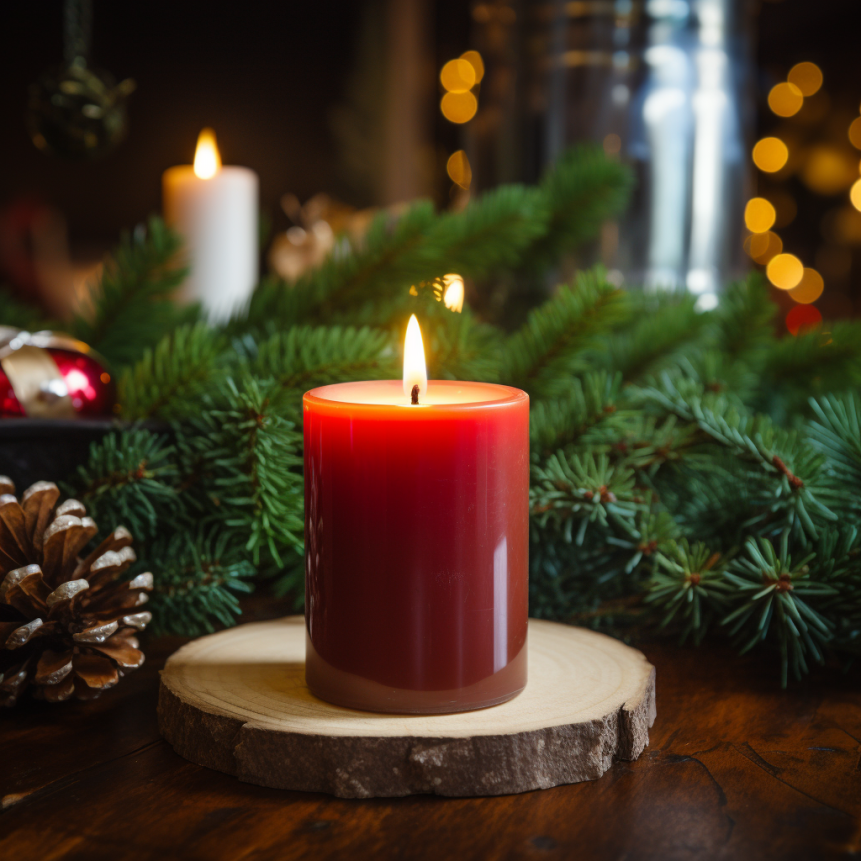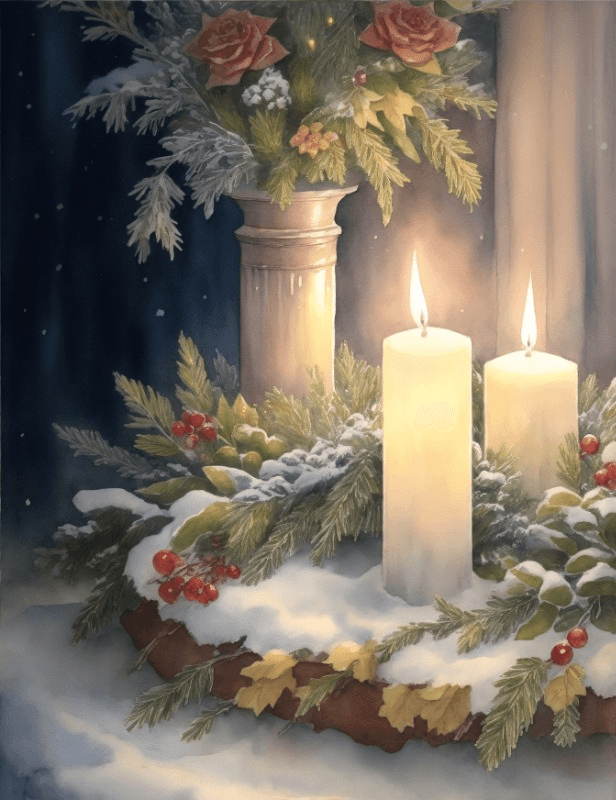
Growing up, I always looked forward to the holiday season. The twinkling lights, the smell of freshly baked cookies, and the joyous atmosphere filled my heart with excitement. But as I got older, I began to question the traditions I had grown up with. That’s when I discovered Yule – a winter celebration that offered a different perspective.
The winter holiday season is filled with sparkling lights, festive decorations, and gatherings with loved ones. For many, this means celebrating Christmas – but for a growing number of people, the winter solstice season is better spent honoring ancient pagan Yule traditions.
By understanding these distinct traditions, you can make an informed choice about which celebration resonates with you.
- Exploring the History of Yule
- Common Yule Colors
- Common Yule Symbols
- Understanding Yule Traditions and Practices
- Exploring Contemporary and Traditional Yule Traditions
- The Influence of Germanic and Modern Paganism on Yule
- Incorporating Witchy and Pagan Elements into Yule Celebrations
- What if I live in the Southwest?
- Embracing the Joy and Spirit of Yule Celebrations
- Comparing Yule and Christmas in Northern Europe
- Celebrating Yule Instead of Christmas
- FAQs
What is Yule?
Yule is a holiday celebrated by modern day Norse pagans, Germanic pagans, Neopagans, and Wiccans around the time of the winter solstice. Historically, Yule festivities were practiced in various forms across Northern Europe by ancient Germanic, Norse, and other pagan groups before the arrival of Christianity.
Today, Yule celebrations typically take place around December 21st, the date of the winter solstice – the longest night and shortest day of the year. This marks the symbolic death and rebirth of the sun, and the shift from increasing darkness to increasing daylight.
For many pagans today, Yule is a time to honor the rebirth of the sun god, who is viewed as the child of the Goddess. Related deities celebrated at Yule include Odin, Frigg, Thor, Freyr, Baldr, and others from Norse and Germanic mythology.
Modern day pagans like Wiccans and Druids celebrate Yule as a time to mark the winter solstice and honor the return of the light. It is seen as a time to reflect on the past year, honor one’s ancestors, and celebrate the days becoming longer.
Yule vs Christmas: Key Differences
There are some key differences between Yule and Christmas that make them distinct holidays:
| Yule | vs | Christmas |
| Yule has pagan origins dating back thousands of years | Origins | Christmas is a Christian holiday |
| Yule coincides with the winter solstice, around December 21st | Date | Christmas celebrates the birth of Jesus on December 25th |
| Yule honors pagan gods like Odin, Thor, and Freyr | Deities | Christmas celebrates the birth of Jesus Christ |
| Yule represents the rebirth of the sun and lengthening days | Symbolism | Christmas celebrates the nativity story of Jesus |
| Yule traditions involve candles, Yule logs, feasting, and honoring ancestors | Traditions | Christmas includes exchanging gifts, singing carols, church services |
| Yule focuses on reflection, honoring nature cycles, and looking inward | Thematically | Christmas emphasizes outward joy, family time, and giving |
Yule Traditions and Rituals
There are many wonderful pagan traditions associated with Yule that create a meaningful alternative to mainstream Christmas celebrations:
Yule Decor
- Evergreens – Decorating with holly, pine, fir, and other evergreens represents lasting life through winter.
- Yule wreaths – Circular evergreen wreaths symbolize the wheel of the year and cyclical nature of the seasons.
- Candles – Lit candles signify the return of light and hope for the coming year.
- Yule trees – Some pagans bring evergreens indoors and decorate them as “Yule trees” instead of Christmas trees.
Yule Activities
- Burning the Cailleach – Some Celtic pagans have a ritual burning of the Cailleach effigy on Yule to symbolize the return of the light over darkness.
- Telling stories – Norse legends and pagan folktales are shared around the fire at Yule.
- Feasting – Yule feasts, roasts, and hearty winter foods are prepared for celebrations with family and friends.
- Gift giving – Exchanging symbolic gifts representing hopes for the new year is a Yule tradition.
- Oak king vs Holly king – Some pagans honor the Oak king defeating the Holly king at Yule, symbolizing the waxing light half of the year.
Yule Rituals
- Yule log – Burning a specially selected Yule log represents bringing light and warmth at the winter solstice.
- Wassailing – Wassail is a warm cider drink used for toasting and honoring ancestors and nature spirits.
- Mumming – Mumming plays telling the story of the battle between the Oak King and Holly King are performed.
- Divination – Pagans may do tarot readings, rune castings, or other forms of divination to get insights for the coming year.
- Honoring the sun – At sunrise on Yule morning, some pagans honor and welcome back the sun.
- Meditation – Meditation, reflection, and inward focus are common Yule rituals.
Common Yule Colors
- Red: Symbolizing Rebirth of the sun and life-giving power
- Hang red ribbons or ornaments or create a centerpiece using red candles.
- Green: Connecting with Nature and fertility
- Decorate your home with evergreen wreaths, garlands, or potted plants. Adorn them with pinecones or berries for an extra touch of natural beauty.
- Gold: Signifying Prosperity and Warmth
- Use golden ribbons or bows to adorn presents, hang golden ornaments on your tree, or place gold accents on your dining table.
Remember, it’s not just about the colors themselves but how they evoke certain emotions and connect us to the natural world around us.
Understanding Yule Traditions and Practices
During the Yuletide celebrations, there are various traditions and practices that people follow to honor this festive season. Let’s explore some of these customs and rituals associated with Yule.
Lighting candles or lanterns represents bringing light into darkness during the long winter nights of Yuletide celebrations.
One significant aspect of Yule is the emphasis on bringing light into the darkness. Many people light candles or lanterns to symbolize this concept. By illuminating their homes, individuals aim to dispel the gloominess of winter nights and welcome warmth and brightness into their lives.
Feasting on hearty foods like roasted meats, root vegetables, and spiced drinks is a common Yule tradition.
Yule is a time for indulging in delicious food that warms both body and soul. Traditional Yule feasts often feature hearty dishes such as roasted meats, savory pies, root vegetables like carrots and potatoes, and warming spiced drinks like mulled cider or hot chocolate. For a unique twist, consider adding spiced cacao to your menu. This magical brew not only warms the body but also adds a touch of enchantment to your Yule celebrations. These scrumptious treats not only satisfy hunger but also evoke a sense of comfort and coziness during the cold winter months.
Exchanging handmade gifts or offering acts of kindness to loved ones is a way to honor the spirit of giving during Yule.
Yule is a season synonymous with giving. Instead of focusing solely on material possessions, many people choose to exchange handmade gifts or perform acts of kindness for their loved ones. Handmade gifts showcase thoughtfulness, creativity, and effort put into creating something unique for someone special. Acts of kindness can range from small gestures like helping with chores to larger deeds that bring joy and happiness to others’ lives.
Participating in rituals such as divination, meditation, or honoring ancestors can deepen your connection to Yule traditions. Similarly, learning how to celebrate imbolc can provide additional insights into seasonal rituals and practices that honor the cycles of nature.
To truly embrace the spirit of Yule, many individuals engage in various rituals that hold deep meaning for them. Divination practices allow people to gain insights into the future or seek guidance during this transformative time. Meditation helps individuals connect with their inner selves and find peace amidst the hustle and bustle of the holiday season. Honoring ancestors is another significant aspect of Yule, as it acknowledges and pays respect to those who came before us.
By participating in these rituals, people can forge a stronger connection to Yule traditions and experience a sense of spiritual fulfillment
Benefits of Celebrating Yule
For modern pagans and others looking for more meaning in the holiday season, celebrating Yule offers many unique benefits:
- Connects with nature cycles and the natural world
- Provides a spiritual alternative to commercialized Christmas celebrations
- Honors ancient pre-Christian winter solstice festivals
- Celebrates the light and return of the sun
- Opportunity to reflect, meditate, and set new year intentions
- Chance to honor pagan gods and goddesses
- Promotes appreciation for the changing seasons
- Encourages simplicity, reflection, and inward focus during the darkest time of year
- Fosters a connection to the cycles of life, death, and rebirth
Blending Yule and Christmas
For those who celebrate both holidays, it is possible to blend Yule and Christmas traditions in meaningful ways:
- Decorate a Christmas tree with pagan symbols like pentacles, runes, and nature images alongside regular ornaments
- Exchange gifts on Yule instead of Christmas morning
- On Christmas, tell stories about ancient Yule celebrations and their meaning
- Cook a Yule feast with ham or lamb on Christmas day
- Do a Yule ritual on winter solstice and attend a Christmas church service
- Sing pagan Yule songs along with regular Christmas carols
- Use Yule herbs like cinnamon, nutmeg, and pine in Christmas potpourris and decorations
Bringing Yule Traditions to Life
As the winter solstice approaches, consider bringing some of the pagan Yule traditions to life in your own way. Celebrate the returning light, honor nature cycles, and reconnect to ancient seasonal customs for a magical holiday season.
Remember, there is no right or wrong way to celebrate Yule. It is about finding what resonates with you personally and creating meaningful moments with your loved ones.
Incorporating Witchy and Pagan Elements into Yule Celebrations
Witches and pagans have their own unique way of celebrating Yule, a pagan holiday that coincides with the winter solstice. During this time, they often incorporate spellwork, rituals, or magickal intentions into their celebrations to honor the changing seasons and connect with nature’s cycles.
To enhance their spiritual connections during Yule, witches and pagans may set up an altar for the wheel of the year adorned with symbols representing the elements or deities associated with winter. This can be a personal and sacred space where they can focus their intentions and commune with the energies of the season. This can be a personal and sacred space where they can focus their intentions and commune with the energies of the season.
Using herbs like cinnamon, frankincense, or pine is another way to infuse a witchy touch into Yuletide festivities. These herbs can be used in spells or as decorations to invoke specific energies or bring about desired outcomes. For example, burning frankincense resin can purify the space and promote spiritual awareness during rituals.
Embracing witchcraft and pagan practices during Yule allows individuals to express themselves authentically while honoring their beliefs. It provides an opportunity for personal growth and reflection as they align themselves with the natural rhythms of the Earth.
While some people may prefer more traditional customs associated with Christmas, incorporating witchy and pagan elements into Yule celebrations offers a different perspective on this festive time of year. It encourages individuals to explore spirituality beyond mainstream traditions and connect deeply with nature.
One benefit of incorporating witchcraft and pagan practices into Yule is that it allows for greater creativity in celebration planning. Witches often craft their own rituals tailored to their specific needs and desires. They may choose to perform spells for abundance, protection, or love during this magical time.
Embracing witchy elements during Yule can foster a sense of community among like-minded individuals who share similar beliefs. Many witches gather together in covens or attend public rituals where they can connect with others who understand and appreciate their practices. This sense of belonging can be empowering and uplifting, especially during the holiday season.
What if I live in the Southwest?
Living in the Southwest, like Arizona, New Mexico, or Utah, doesn’t mean you can’t celebrate Yule in your own unique way. Remember, Paganism is a personal practice and doesn’t have to fit into the traditional mold. Embrace your surroundings and incorporate elements from the desert landscape into your Yule celebrations.
Incorporate Native Plants
- Decorate with juniper, piñon pine, sage, and other native greenery. These plants connect you to the local landscape.
- Make wreaths using succulents like agave and yucca. Add in some evergreen clippings as well.
- Burn native plants like white sage, piñon, and desert lavender to cleanse your space.
Bring Nature Inside
- Gather interesting rocks, dried pods and seed heads, feathers, and other natural items to decorate your home.
- Make a Yule altar with items from the desert like antlers, animal bones, and crystals.
- Place bowls of sand, rocks, and desert plants around to symbolize the landscape.
Connect with the Sun
- Perform solar rituals outside at sunrise/sunset on the solstice. Welcome back the sun.
- Light many candles and fires to celebrate the returning light.
- Take a meditative walk and observe how the low winter sun impacts the desert.
Celebrate the Season
- Make warm wassail with local fruits like prickly pear.
- Feast on regional foods like posole, tamales, and biscochitos.
- Get outdoors – go hiking or have a bonfire. The cooler weather is perfect.
Honor Local History
- Research how native tribes like the Navajo and Hopi celebrate the winter season.
- Visit ancient petroglyph sites tied to winter solstice rituals.
- Tell traditional stories from the area around the fire.
Blend Yule and Southwest Traditions
- Decorate a Christmas cactus for the season.
- Make luminarias with candles in paper bags to light your home.
- Give gifts like dreamcatchers, turquoise jewelry, and pottery on Yule morning.
Connecting with Nature’s Elements
- Earth: Collect rocks or sand from local desert areas to represent the element of earth on your altar.
- Air: Hang wind chimes or feathers near windows to symbolize the element of air and invite positive energies into your space.
- Fire: Light candles in colors reminiscent of the Southwest, such as warm reds, oranges, and yellows. Be sure to practice fire safety precautions!
- Water: Place a small bowl of water on your altar to honor the element of water. You can also visit nearby lakes or rivers if accessible and spend some time reflecting by the water.
Remember, there are no hard and fast rules. It’s all about embracing your surroundings and incorporating elements that resonate with you personally.

Why Celebrate Yule Instead of Christmas?
Here are a few key reasons why some people choose to celebrate Yule instead of Christmas:
- Yule has pagan origins and pre-dates Christmas as a winter solstice celebration. It provides a spiritual alternative to the increasingly commercialized and secular Christmas holiday.
- Yule focuses on honoring nature and the cyclical turning of the seasons, rather than the nativity story of Jesus that is central to Christmas. Take the opportunity to connect with the natural world around you. Spend time outdoors, go for a winter walk, or have a bonfire under the starry sky. Embrace the beauty of nature during this season and appreciate its resilience. You can also incorporate natural elements into your decorations, such as using pinecones, acorns, or dried flowers.
- The traditions and rituals of Yule, such as burning the Yule log, decorating with holly and ivy, and feasting, derive from pre-Christian pagan customs. These can hold more meaning for those following neo-pagan paths today.
- Celebrating on the actual winter solstice, around December 21st, feels more significant for many pagans today than celebrating on an arbitrarily chosen date like December 25th.
- Yule emphasizes inward reflection, rebirth, and preparation for the return of the sun over outward materialism. For some, it evokes a more spiritual tone than Christmas.
- Spending 12 days celebrating Yule allows more time to spend with family and friends over the holiday season, without the compressed hype of Christmas Day.
- Yule brings people closer to the natural rhythms of the solar year, changing seasons, and circle of life – themes that can get lost during the Christmas holiday.
- For those who do not subscribe to Christianity, Yule provides a non-religious way to celebrate the winter season and solstice in a meaningful, spiritual way.
So in summary, celebrating Yule is seen by many pagan-practicing people as deeply connecting them to nature, their ancestors, and their own spirituality in a way Christmas does not. The solstice and Yule traditions pre-date Christmas, so for them it feels like a return to ancient roots.
Remember, celebrating Yule is all about finding joy and meaning in the natural world around us. It’s an opportunity to slow down, reflect on the past year, and set intentions for the future. So go ahead and infuse your Christmas holiday season with a touch of magic by embracing Yule traditions. Happy celebrating!
FAQs
What are some traditional foods associated with Yule?
Yule is often celebrated with delicious feasts that bring warmth and comfort during the winter season. Traditional foods include roasted meats like ham or turkey, root vegetables such as potatoes and carrots, spiced cider or mulled wine, gingerbread cookies, fruitcakes, and hearty soups.
Can I celebrate both Christmas and Yule?
Absolutely! Many people choose to incorporate elements from both holidays into their celebrations. You can blend traditions by decorating a Yule tree alongside a Christmas tree or incorporating symbols from both holidays in your decor. Remember that celebrating any holiday is ultimately about what brings you joy.
Are there any specific rituals associated with Yule?
Yes! There are various rituals you can perform during Yule to honor the winter solstice and embrace its spiritual significance. Some common rituals include lighting candles to symbolize bringing light into the darkness, creating a Yule log and burning it in the fireplace, or performing a meditation to reflect on the past year and set intentions for the coming months.
How can I involve my children in Yule celebrations?
Involving children in Yule celebrations can be a wonderful way to teach them about nature, traditions, and spirituality. You can engage them by making Yule crafts together, such as creating ornaments or decorating candles. Reading stories about Yule or going on nature walks to gather natural materials for decorations are also great ways to involve children in the festivities.
Can I celebrate Yule if I don’t follow any specific religious or spiritual path?
Absolutely! Yule is not limited to any particular religion or spiritual practice. It is a celebration of nature’s cycles and can be enjoyed by anyone who appreciates its beauty and significance. Whether you identify as pagan, atheist, agnostic, or follow a different faith altogether, you can still embrace the spirit of Yule in your own unique way.





